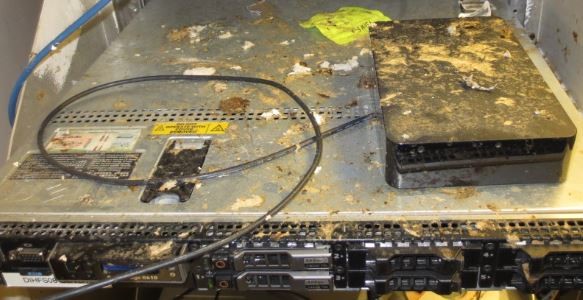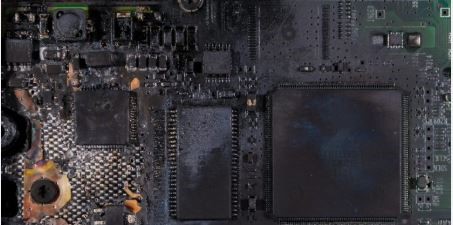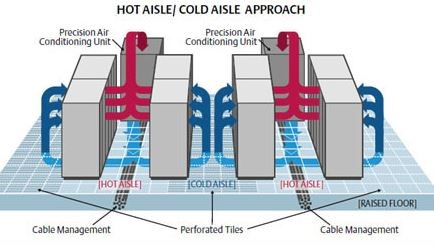Monsoon Storms can cause…
- Shorts and Damage from WATER
- POWER Surges and Outages
- Failure from Excessive HEAT
WATER – In your server/comm room, look for gaps between floor, walls, and ceiling, and around conduit entry paths and terminations. Water will follow cables into rack-mounted and free-standing devices, then pool in low points on the floor. Being a good conductor with little resistance, water lets big current flow where it shouldn’t, zapping components in it’s path. Many solders, solder paste, flux, and copper trace material tends to corrode when water is introduced. Below is shredded fibrous material that fell from soaked ceiling tiles onto a rack mounted server, thankfully this is not one of our customers.

Water Prevention Tips for Server Room
- Avoid server room locations in basement or near exterior wall or wet walls with attached pipes.
- Mount all equipment in rack, raised off floor.
- Install fire-suppression system (FM200), cap off water-based sprinkler heads.
- Keep a roll of sheet plastic, duct tape, and silicone sealer handy.
- Silicone-seal gaps/holes in walls, floor, ceiling, hard-ceiling above drop ceiling.
- Consider water detection system in server room that sends alerts.
- Send maintenance up to patch holes and seams in roof above server room.
- Get rid of water and foam fire extinguishers and replace with Class C rated models using HaloCarbon, FE-36, Halon 1211 or C02, none of which leave liquid or residue.
- Cap off water-based sprinkler heads, but check with your local fire department for regulations.
POWER – Spikes, shorts, brown-outs and outages cause unplanned shutdowns at best, but can damage electronics, destroy data and cause extended downtime for a business. Often caused by lightning strikes or downed power lines, these can also be caused by electricity shorting through water paths, and when networking devices fail they can send power surges through connected cables, frying connected components along the way as shown below.

Tips to Avoid Power Issues
- Label all cables and cable-bundles in server rooms, and label all circuits in breaker box.
- Don’t save money on Uninterruptible Power Supplies (UPS battery backups), rather budget and select a model based on it’s quality and available power in VA. Available power should exceed the sum of power required by all devices to be plugged in.
- Inspect the health of batteries inside UPS devices using their front display or dashboard, and replace batteries nearing end of life.
- Make sure all server racks have a ground wire attached to building and earth ground.
HEAT – Monsoon storms are accompanied by excessive heat. As the surrounding temperature rises, so does the temperature near external walls and inside server rooms, where dust accumulates inside enclosures and airflow around components slows down.
Most electronic components have temperature sensors that notify when limits are exceeded, and can even initiate shutdowns to avoid damage. The best prevention is adequate airflow around the devices in a relatively dust-free environment, with all internal fans working well.
Here is a good thermal design with “cold aisles” supplying conditioned air through hot rack space and “hot aisles” exhausting the resulting heated air. Even a small fan directed at a hot device can provide adequate cooling, but should be used as a temporary measure until a better solution can be implemented. For more information on server closet/room cooling strategies, see APC/Schneider Electric’s – Cooling Strategies for IT Wiring Closets and Small Rooms.

Monsoon storms can be dramatic and so can the damage they leave behind. With a little attention before they start, you can protect your infrastructure, data and operations.
Your Technology Partner,
The LeeShanok Team
Tucson: 520.888.9122
Phoenix: 602.277.5757
